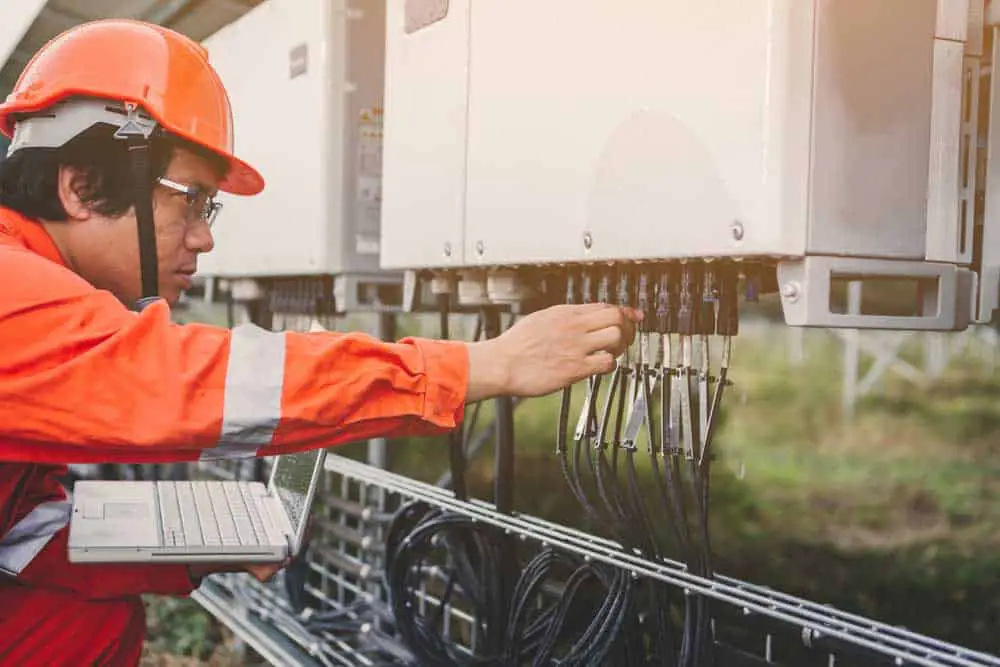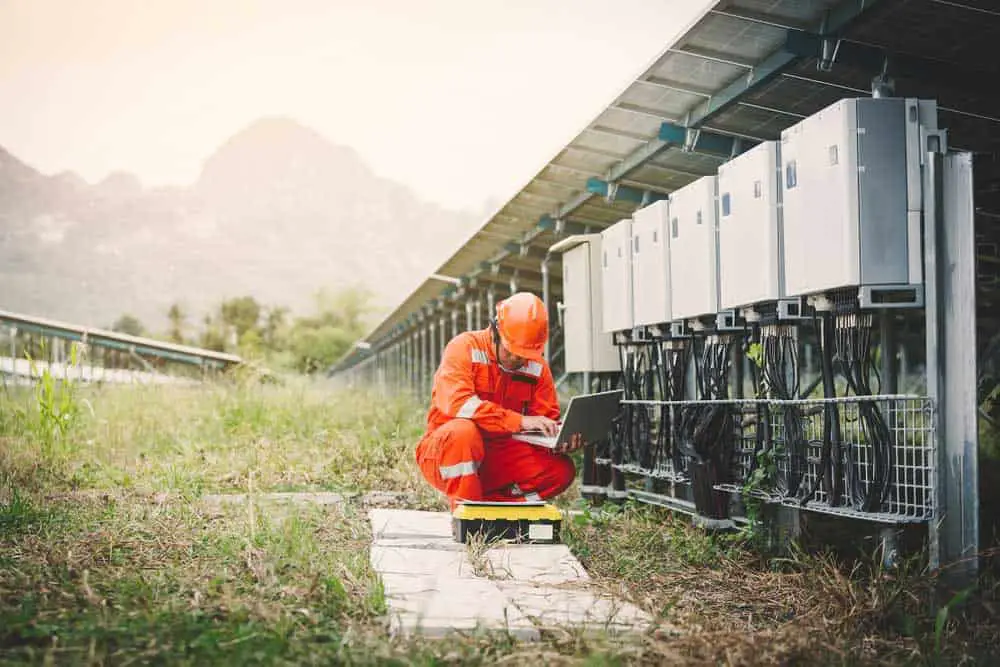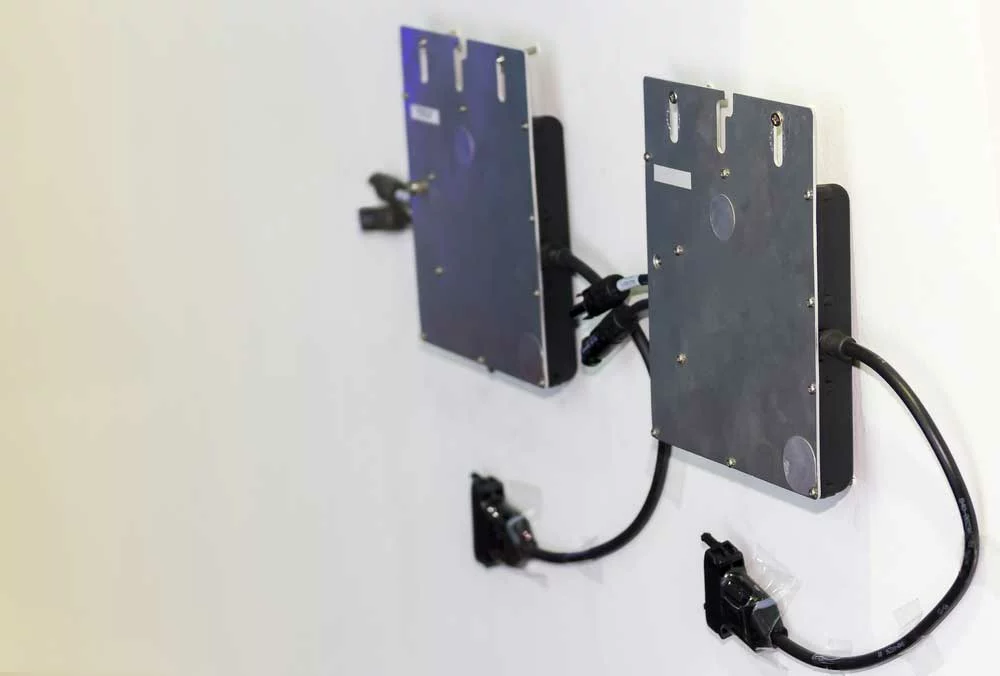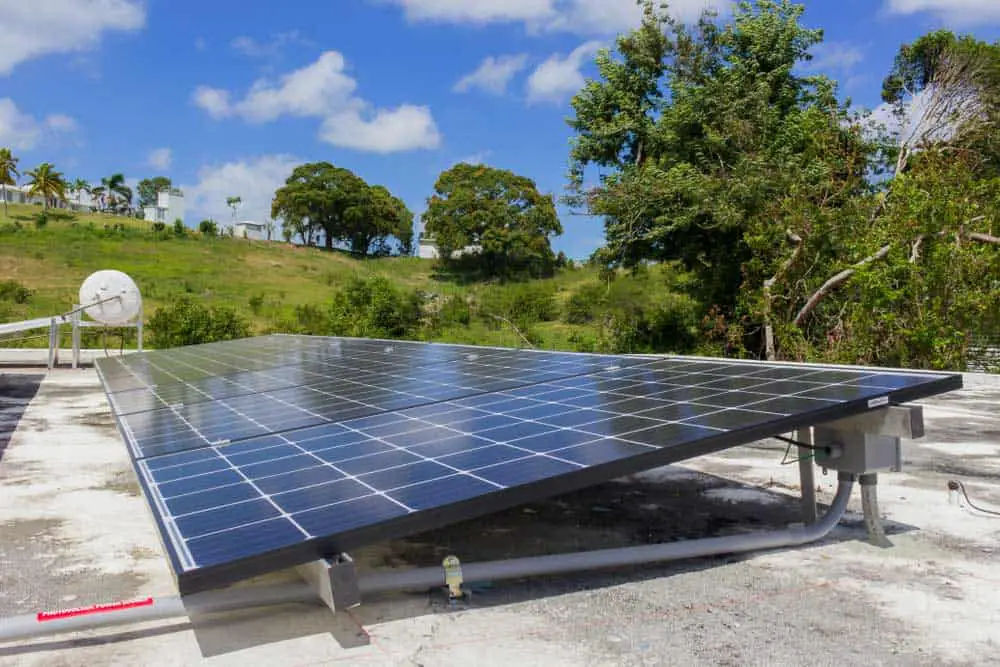An inverter is one of the most critical electronic devices required in a solar energy system. Although the device’s primary purpose is to convert DC to AC, it comes in different types that differ in multiple aspects, such as performance. String inverters are the industry standard, but micro-inverters are beginning to give them a run for their money. We will compare string inverter vs. microinverter to help you determine the most suitable device for your solar project. Let’s get started!
What is a String Inverter?
String inverter systems use a centralized power-point design to convert DC from solar panels to AC for grid or household use. The string is a series of solar panels connected in series. And the inverter can handle 6-12 of them.

An engineer inspecting string inverters after connecting to them via WiFi
These inverters offer the cheapest and simplest conversion options, with residential solar installations requiring one or two, depending on the solar array size.
String Inverter vs. Microinverter: Advantages of String Inverters
Standard string inverters are ideal for solar panel installations that receive maximum sunlight and have the solar panel series installed as one large grouping. This setup has the following advantages.
Low Cost
Inverters are not cheap. So installing one device to manage a string of panels is less costly than buying several units for individual solar panels. Also, you will use or pay for fewer labor hours for the installation job.
Easy to Use and Troubleshoot
Since you’ll only be using one central inverter, the solar system will be easy to operate. And if anything fails, it will be easy to find the cause of the issue from the single unit.

String inverters under solar panels
Low Probability of Miswiring
A single inverter requires minimal wiring, which minimizes the chances of incorrect connections. This design also simplifies maintenance compared to micro-inverter systems.
Cons of String Inverters
No Single Panel Monitoring
A string inverter cannot provide panel-level monitoring because it handles 6-12 panels simultaneously. Therefore, you won’t be able to see individual panel-level performance issues caused by cracks, debris, defects, etc.
Low Efficiency in Shaded Areas
String inverters require the strings of panels in a series connection. In this setup, the power output from a single panel affects that of its counterparts in the array. Therefore, the system will experience low-efficiency levels in partial shade because some modules will have a lower output.

String inverters in a solar farm
Difficult System Expansion
String inverters deliver optimal performance when they operate at near-peak capacity. Therefore, if you want to increase the size of the solar array, you might have to reroute some of the panels to a separate string inverter. This difficulty increases the cost and complexity of expansion.
Short Lifespan
Micro-inverters usually have a 20 to 25-year warranty. However, string inverters average 8 to 12 years. This difference shows they have a shorter lifespan because manufacturers can only offer extended warranty periods if they are sure the product will perform optimally during the time.
What is a Micro-Inverter?
Micro-inverter systems have the same function as their string counterparts (DC to AC electric power conversion). However, these individual inverters handle single panels. So a solar energy project with micro-inverters will have the same number of solar inverters as the panels.

Micro-inverters
String Inverter vs. Microinverter: Advantages of Micro-Inverters
Panel Level Monitoring
Since each panel has its separate inverter, the system gives a higher monitoring level than the string inverter setup.
More Power
Micro-inverters yield more solar power because the system experiences slight differences in currents between individual solar modules. With string inverters, the output reduces to match that of the least-generating panel.
Rapid Shutdown Capability
The latest electrical codes require rapid solar shutdown to keep firefighters and first responders safe from high-voltage electricity in case of emergencies or repairs. Micro-inverters can shut down the power output because all individual modules have this feature.

Micro-inverters are placed under solar panels.
Ideal for Challenging Installation Conditions
Micro-inverters are the best solution if the panels face opposing sides or experience different shading issues caused by objects like trees. The power production from these panels will vary, but micro-inverters will harvest all the available energy without one solar panel affecting the other.
Easy System Expansion
Expanding this system with additional panels is simple because you only have to get a corresponding inverter and wire them to the grid.
Long Lifespan
As stated earlier, micro-inverters usually have 20 to 25-year warranty periods.
Cons of Micro-Inverters
High Cost
Inverters usually cost upwards of $1,000. So each panel in the solar project will require $1,000 at minimum for AC conversion.
High Maintenance
Since there are multiple inverters in the system, it can be challenging to detect a failing unit. And once you find it, you will have to unbolt the individual module, replace it, then re-establish & reconnect the AC power to the grid.

A side view of installed solar panels
Requires More Space
Although micro-inverters are more compact than their string counterparts, they still take up space. With each panel having its module, your roof can get crowded quickly.
String Inverters vs. Microinverters: Which is Better?
There isn’t one inverter that is better than the other in all applications. It all depends on several factors, such as:
- Durability
- Price
- System expansion
- Monitoring
- Safety
- Performance
- Installation
But keep in mind inverters are the most complex devices in solar systems. So they are the most likely to fail. Therefore, installing an inverter for each panel can be tricky and expensive unless your rooftop experiences shading issues.
Micro-inverter manufacturers usually market the individual-panel monitoring feature as a significant advantage. However, this feature does not usually get to the customer unless you pay extra. Manufacturers mostly give the installer access to the panel-level data. So you only get system-wide monitoring, like in a string inverter.

Solar panels on a rooftop under the shade
They usually do this to reduce customer support calls about non-functioning inverters, especially during the warranty period. With system-wide monitoring, you won’t be able to detect one or two broken inverters out of 30 or 50 in the system.
Therefore, if you go for the micro-inverter, ensure you get the panel-level monitoring feature, even if it costs extra. But a string inverter is better and cheaper if your roof is clear of any shade from dusk to dawn.
String Inverter vs. Microinverter: Can You Combine Micro-Inverters and String Inverters?
It is possible to create a hybrid inverter containing the two systems. And it is known as a power optimizer. The setup consists of small devices that connect to each panel, like micro-inverters.
However, these units don’t convert DC to AC. Also known as maximizers, these optimizers condition each panel’s DC power to maintain maximum power output even if one module is under shade. Additionally, these devices enable you to monitor each panel’s power output.

A DC power optimizer
The optimizers then connect to a string inverter for DC-to-AC conversion. And you can wire 8-25 optimizers to create a DC string depending on the cumulative panel voltage. Generally, the string voltage can go up to 500V. The setup is up to 2% more efficient than string inverters under direct sunlight and 25% under shady conditions.
Adding optimizers to a string inverter system increases the project cost, but it is cheaper than installing micro-inverters. So why should you consider micro-inverters?
Micro-Inverters vs. Optimizers
Micro-inverters have two primary advantages over optimizers. First is the after-sales service. They come with 20 to 25-year warranties, matching that afforded to solar panels. Investing in solar is a long-term game, so this deal is much better than the 12-year warranty given to string inverters.
The second is scaling. Expanding a solar micro-inverter system to power more household appliances or charge your EV is less complex than adding optimizers and possibly an extra string inverter.

EV charging using solar
Wrap Up
In conclusion, both string and micro-inverters have unique advantages that make them ideal for specific applications. There is also the option of using the string optimizer combo to enhance the system’s efficiency while keeping costs low. We hope the comparison will help you pick the ideal inverter system, and if you have any questions, contact us for further details.
